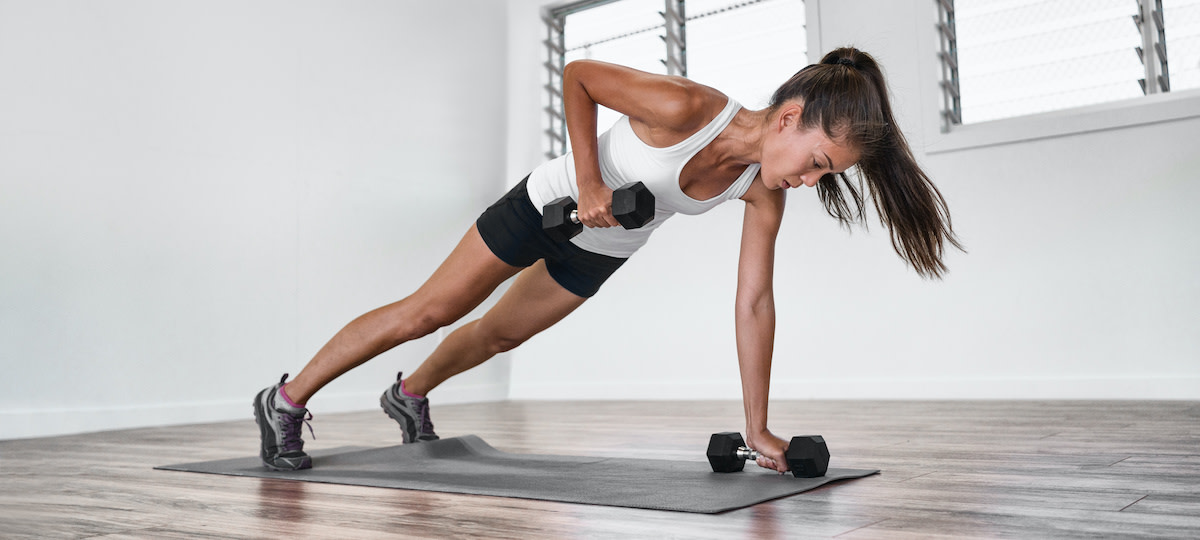Renegade Row Guide: How to Master the Renegade Row
Written by MasterClass
Last updated: Sep 20, 2021 • 3 min read
If you want to incorporate more advanced core exercises into your bodybuilding program, consider practicing the renegade row.
Learn From the Best
What Is the Renegade Row?
The renegade row is an advanced row variation characterized by holding your body in a plank position with one hand while lifting a dumbbell with the other hand. Renegade rows are full-body exercises that simultaneously activate core muscles like the obliques, back muscles like the rhomboids, and arm muscles like the triceps. With proper form, renegade rows can develop upper body strength while improving balance and stabilization.
Renegade Row vs. Bent-Over Row: What’s the Difference?
While both exercises are row variations, the renegade row and the bent-over row are different in a few key ways.
- Posture: The clearest difference between renegade rows and bent-over rows is the posture. While the renegade row involves a plank position with your back and legs in a straight line, the bent-over row is defined by hinging your hips to lower your upper body in a standing position.
- Muscles prioritized: While both row variations work many of the same muscle groups, the renegade row is a more comprehensive exercise than the bent-over row, activating muscle groups across your entire body, including your arms, upper back, lower back, and legs.
- Equipment: Although there is a bent-over dumbbell row variation, the conventional bent-over row uses a barbell. In contrast, the renegade row uses a pair of dumbbells.
- Difficulty level: The renegade row is a more advanced row variation, as it activates more muscle groups and requires core stabilization during a unilateral movement while you hold your bodyweight with one arm. Remember to warm up before performing the renegade row, and start with lighter-weight dumbbells.
- Variations: There are several bent-over row variations, including the T-bar row and landmine row. In contrast, some renegade row variations use kettlebells or change the posture of the movement to make it easier, as with the kneeling renegade row.
How to Do a Renegade Row
For the renegade row, begin by using a weight that you can control for 2–3 sets of 5–8 repetitions on each side. Choose a weight that allows you to maintain good technique throughout all sets and repetitions.
- 1. Grab two dumbbells and get into an all-fours position with your knees and toes flexed and in contact with the floor. Your hips should be over your knees. The dumbbells should be slider wider than shoulder-width apart.
- 2. Straighten your legs to lift your knees off of the ground so you end up in a pushup position. Move your feet slightly wider than your hips for greater stability.
- 3. Pre-tension your shoulders and hips while engaging your core. Squeeze your quads and glutes. Rotate your shoulders outward to engage your lats. Your chin should remain tucked throughout the movement, as if you were holding an egg under your chin. All repetitions should begin from this position.
- 4. While maintaining your alignment, pull one dumbbell toward your hip by using your lat and bending your elbow. Your elbow should be 30–45 degrees away from your body. Your shoulder blades should retract as you pull the dumbbell toward your hip. Your upper arm should be in line with your body with a neutral wrist. Your hips and shoulders should be squared toward the floor.
- 5. Pause for 1–2 seconds at the top of the movement.
- 6. Slowly return the dumbbell to the starting position.
- 7. Repeat the upward movement on the opposite side.
- 8. After you perform a rowing action on each side, you’ve completed one full repetition.
How to Work out Safely and Avoid Injury
If you have a previous or pre-existing health condition, consult your physician before beginning an exercise program. Proper exercise technique is essential to ensure the safety and effectiveness of an exercise program, but you may need to modify each exercise to attain optimal results based on your individual needs. Always select a weight that allows you to have full control of your body throughout the movement. When performing any exercise, pay close attention to your body, and stop immediately if you note pain or discomfort.
In order to see continual progress and build body strength, incorporate proper warm-ups, rest, and nutrition into your exercise program. Your results will ultimately be based on your ability to adequately recover from your workouts. Rest for 24 to 48 hours before training the same muscle groups to allow sufficient recovery.
Want to Dive Deeper Into Your Wellness Journey?
Throw on some athleisure, fire up a MasterClass Annual Membership, and get ready to sweat it out with exclusive instructional videos from Nike Master Trainer and GQ fitness specialist Joe Holder. Want to improve your cardiovascular endurance? Give Joe’s HIIT workout a go. Trying to get a little swole? He’s got a strength training workout for that. From fitness tips to nutrition hacks, Joe will have you feeling healthier in no time.
